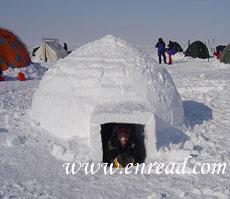爱斯基摩人的冰屋大家一定都听说过吧?这可是名副其实的冰雪房子。爱斯基摩人冬天狩猎的时候就会用这些冰屋做休息站。如果你想体验住在冰屋的感觉的话,你可以去瑞典北部基律纳的朱卡恩佳维村,住宿那里的冰旅馆。在亲身体验之前,所有人都担心的问题就是:这个冰屋里面会不会融化?毕竟人类的呼吸和活动可是会释放很多热量哦!就让下面这篇文章来解决您的担忧吧!

The igloo, a temporary winter hunting shelter to the Alaskan Inuit does, in fact, melt inside, but not to a great extent.
The snowflakes falling outside of the igloo, in the harsh Alaskan winter, quickly melt when they land on its roof, and provide a replacement1 layer of insulation2 for the igloo. The ongoing3 freezing and re-freezing of the igloo, hardens it, and transforms the blocks of snow the Eskimos used in the construction process into a solid, icy, domed4 refuge. The igloo can now withstand the weight of a massive polar bear, should one happen along and have the urge to play "king of the mountain."
The initial freezing and re-freezing of the igloo takes place at the end of the igloo's construction. First, the men must dig a trench5 into a fresh snow- drift, and, using their knives, cut blocks of snow from it that are specifically shaped to face inward when fully6 laid out. They then lay the blocks on their edges to form a circle, cutting them to size as they go, so that the end result will be a narrowing spiral. They cap the igloo by dropping a keystone, or block with edges cut wider above than below, into the remaining gap in the roof, and "grout" the gaps between blocks of snow with additional snow.
The men then call in the resident expert, the Inuit woman, to put the finishing touches on the igloo. Armed with her whale blubber lamp, she enters the structure, lights her lamp to the highest possible setting, beats a hasty retreat, and seals the entrance with a block of ice. Inside the igloo, the snow on the roof begins to melt but, because of its domed design, the water melts down the sides of the igloo, and soaks the blocks of snow. When the blocks are almost completely saturated7 with water, the woman returns, douses8 her blubber lamp, and allows the frigid9 outside air to rush in, transforming the fragile snow structure into one of hard, solid ice.
The igloo is now prepared for its temporary tenants10, whose body heat, combined with the warmth of one to two blubber lamps, maintain its interior at approximately 55°F. Not until the winter ends, and the exterior11 temperature rises, does the igloo begin to melt. Hopefully, the Inuit will be long gone by then, as the igloo will collapse…dome-first!
 收听单词发音
收听单词发音 



